Even if you’re aiming for a Band 6 or higher, it’s hard to finish all three IELTS Reading passages by reading every word. As one expert puts it, there simply isn’t enough time to read each passage slowly and carefully in the 60-minute test. That’s why scanning is so important. Scanning is a fast reading skill that lets you zero in on specific information (like names, dates, or keywords) without reading the whole text. As the Cambridge English experts explain, “Scanning means quickly searching a passage for a particular word or term (e.g. a name or a date)”. In this guide, we’ll show you how to practice IELTS reading scanning using keywords. We’ll explain what scanning is (and how it differs from skimming), give you practical step-by-step tips, and even walk through sample passages and exercises. By the end, you’ll feel confident scanning effectively at any level (Band 6–8+) so you can save time and boost your score.
Skimming vs. Scanning: What’s the Difference?
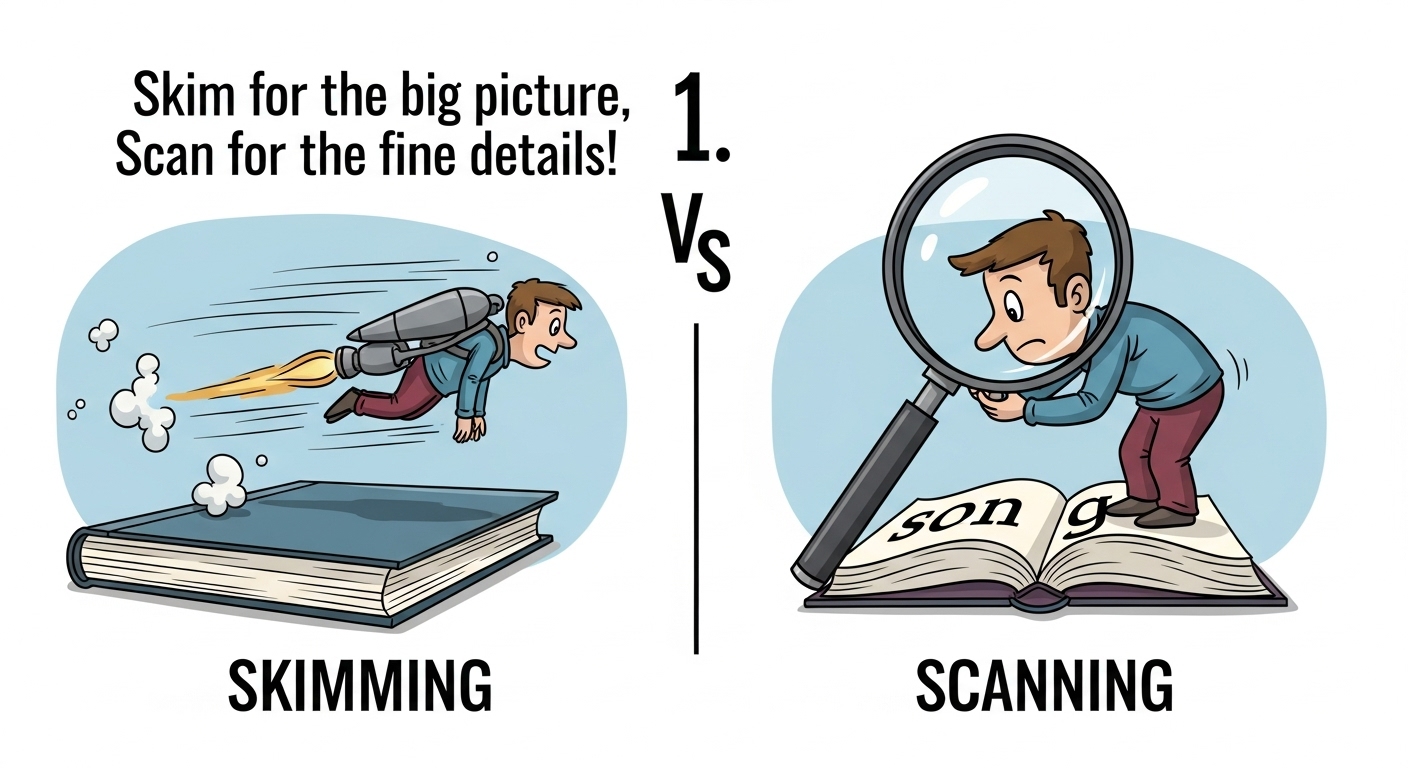
Before diving into scanning practice, it helps to understand how skimming and scanning differ. Both are fast-reading techniques, but they serve different purposes:
Skimming gives you a general overview of the passage. You might read the title, headings, and first sentence of each paragraph to grasp the main ideas. It’s like a quick survey of the passage’s topics without worrying about details. Scanning zeroes in on specific information. You already know what you want (from the question), and you search quickly to find that exact word or detail. Think of it as running your eyes over the text to spot key terms. Cambridge exam expert Pauline Cullen emphasizes that skimming is used for overall understanding, whereas scanning is the skill to locate relevant parts of the text for specific questions. In practice, you usually skim first to get the gist, and then scan when answering detailed questions.
For example, if a question asks “When did Jane Smith publish her research?”, you would skim the passage to get a rough idea of the content, but then scan for Jane Smith’s name or a year to answer precisely. In short: Skim to understand the big picture; scan to find precise answers. Both skills are essential on test day. As another IELTS source notes, skimming and scanning are “two key reading skills that students are being tested on in the reading test”.
Why Scanning Matters in IELTS Reading
The IELTS Reading section has a strict time limit – just 60 minutes for 3 passages. That means you can’t afford to read word-by-word like a leisure reading exercise. In fact, the IELTS test is designed to reward smart strategies over exhaustive reading. As Magoosh notes, “there simply isn’t enough time on the IELTS Reading paper to read each passage slowly and carefully and answer all of the questions”. Without scanning and skimming, many test-takers run out of time. Here’s why scanning with keywords is a game-changer:
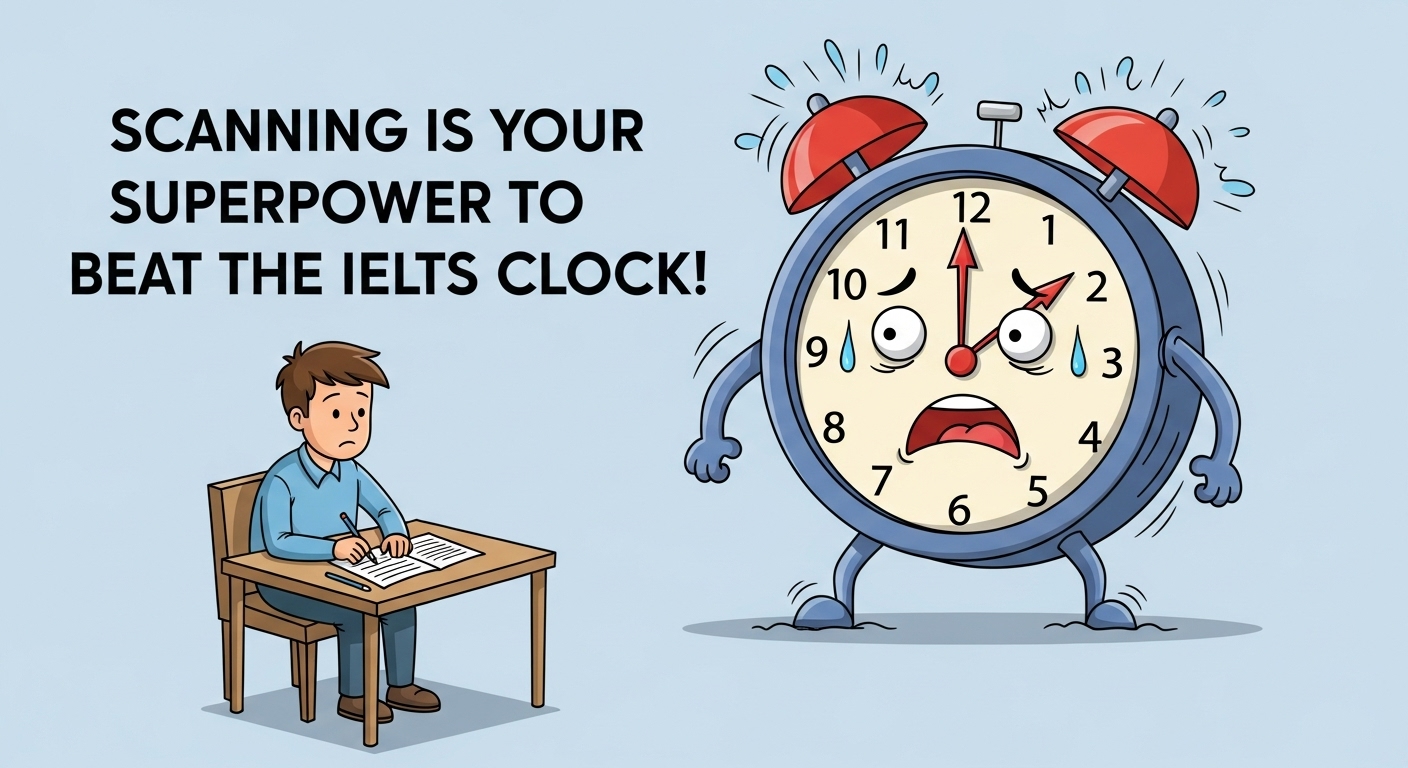
- Time-saving: Instead of reading the whole passage, scanning lets you jump straight to the parts that answer the question. This is the fastest route to the answer, saving precious minutes.
- Accuracy: By focusing on specific keywords from the question, you reduce the chance of getting lost in irrelevant details. You’ll find the exact phrase or idea that the question is asking about.
- Higher score potential: Knowing how to scan efficiently is crucial for higher bands. Test makers expect advanced candidates to use these skills. For example, Cambridge’s Pauline Cullen explains that in higher-level tasks like matching headings, you first scan for people’s names and then skim around those spots to decide the answer.
- Exam strategy: Scanning is especially useful for question types that target specific facts – such as True/False/Not Given, Multiple Choice, Matching, or Short Answer questions. In fact, the IELTS material on keyword technique recommends starting with questions that have identifiable names or places, since those are easy to scan for. In short, scanning with keywords is an essential strategy for handling IELTS Reading efficiently. It’s not a trick; it’s a skill to practice and master. As one official IELTS source advises, first read the questions and highlight the key words, then “scan the passage for answers”. Later we’ll show exactly how to do that.
Step-by-Step Scanning Strategy
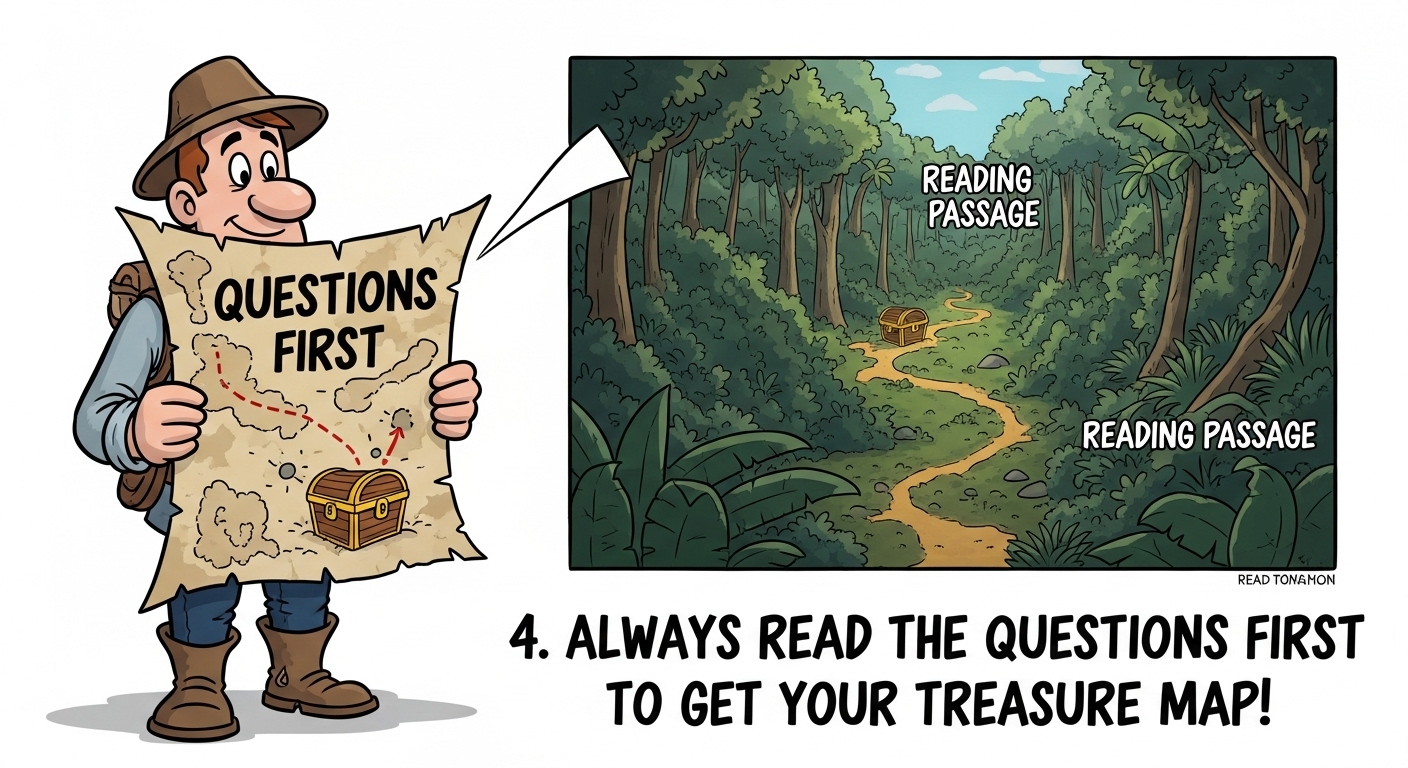
Now let’s break down the scanning process into clear steps. You can follow these steps every time you do an IELTS Reading practice:
- Read the Questions First. Always start by reading (or at least glancing at) the questions for the passage. This tells you what you’re looking for in the text. Underline or highlight the important words in each question – these are your keywords. For example, if a question asks “What year did X happen?”, key words might be “year” and the subject X. Magoosh recommends identifying these keywords because “questions almost never use the same language as the passage – instead they will be paraphrases”. By underlining the keywords in the question, you focus on the ideas you need to search for in the passage.
- Identify the Keyword Types. Not all keywords look the same. In scanning, certain types of words are especially useful to look for:

- Proper nouns and names. People’s names, company names, or character names stand out in text. IELTS experts note that names often appear several times in a passage, and they are easy to spot. For example, if a question mentions “Dr. Wang”, you can quickly scan the passage for “Wang” or “Dr. Wang.”
- Dates and numbers. Any numbers (years, statistics, percentages) are obvious scanning targets. Numeric data often jumps out visually. As Magoosh points out, a date like “1950” would be very easy to locate in a sea of words.
- Location names. Place names (cities, countries, rivers) are also easy to find when scanning since they often stand out.
- Technical terms or key nouns. If the question uses a special term (e.g. “enzyme”, “constituent”, “Sahara”), search for that term or its root. Even if the exact word isn’t in the text, look for synonyms or related terms (see next point).
- Signal words or change words. Sometimes questions ask about relationships, comparisons, or changes (words like “however,” “in contrast,” “gradual,” etc.). Scanning for such connectors can help locate important context. Official IELTS advice confirms: “Key words are most important when scanning… such as proper nouns, dates, numbers, and times”. Always jot down in your mind (or on scratch paper) what kinds of words matter for each question.
- Use Synonyms and Paraphrase. Remember, the exact wording in questions might not appear verbatim in the passage. The IELTS will often paraphrase. So if a question says “gender difference”, the text might say “the discrepancy between males and females”. Scanning relies on meaning as much as words. Magoosh emphasizes that by highlighting question keywords you’re finding the ideas to look for, not just the same words. For example, if a question mentions “rapidly increasing population”, the passage might say “population has grown swiftly”. When scanning, you won’t find the exact phrase, but you’ll spot the idea by catching synonyms like “population” and “swiftly”. In practice, quickly think of 1–2 synonyms for each keyword as you scan.
- Follow a Scanning Pattern. Use your finger or a pencil to guide your eyes and scan systematically. For instance, if you’re looking for a particular name or number, start at the top of the paragraph and sweep your eyes slowly down the page (column by column if needed). You can also read the first few and last few words of each line if that helps your eye recognition. The official IELTS scanning tips suggest using a finger or pen to guide you and even circling or underlining key words in the passage. This physical motion keeps your eyes focused and prevents random wandering.
- Use Headings and Paragraph Structure. If the passage has headings or is split into paragraphs, use them. For example, if a question is about environmental issues, scan paragraphs with relevant headings. Even without headings, often the first sentence of each paragraph contains the main idea. If a question is general (like match a paragraph to a topic), you might skim first (see next tip). But for scanning specific details, glance at each paragraph’s opening or any subheading.
- Start with Easy Questions. Magoosh recommends tackling the questions with obvious keywords first. For instance, if a question has a name or date you can instantly find, do it first. This builds confidence and helps you understand the passage content as you go. Often in True/False/Not Given or Multiple Choice sections, unique names or places act as anchors. IDP IELTS advises starting with questions containing easy-to-scan words like names or place names.
- Confirm with Context. Once you find a keyword, don’t just mark it as the answer. Read a few words before and after the keyword to ensure it fits the question. Scanning gets you to the right area, but you still need to confirm the meaning. For example, if the question asks “A made statement X”, find A’s name, then see if X is indeed stated there. This is still reading, but only around the target rather than the whole text.
- Practice Timed Scanning. Finally, practice under a timer. IELTS is about efficiency. The Cambridge guide suggests regular timed drills: skim and scan passages for specific info within a limited time. Start with generous time (e.g. 15 minutes for a short passage and 5 questions), then gradually tighten it. This trains you to recognize keywords faster and trust the scanning process. By following these steps — question first, keyword focus, systematic scanning, and context-checking — you’ll tackle IELTS Reading passages much more efficiently. Let’s see how this works with actual practice.
Practice Exercise 1: Short Passage and Scanning
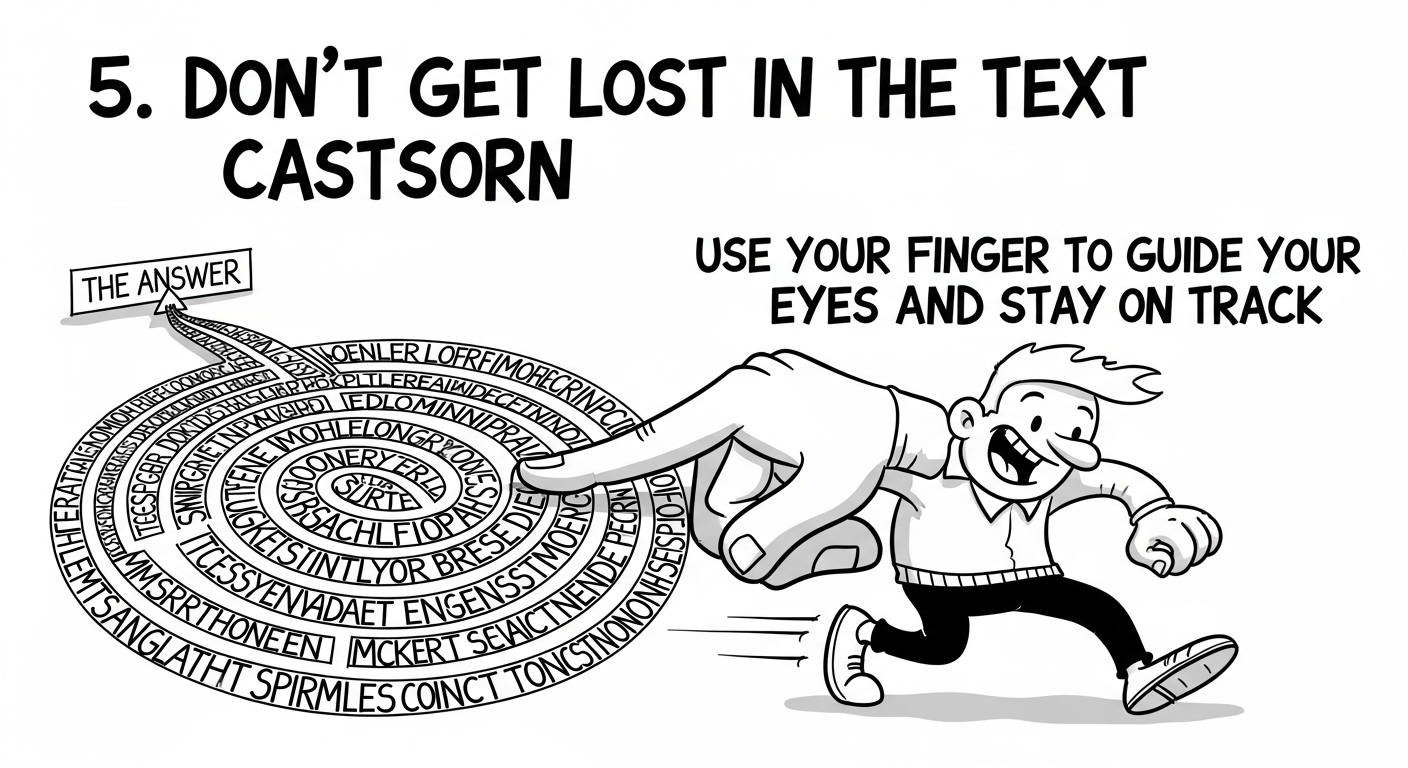
To see scanning in action, try this short practice passage and questions. Don’t read it top-to-bottom yet! First read the questions and identify the keywords you need to scan for. Passage (about rainforests) (Note: Passage is 150 words) (A) Tropical rainforests are vital for the planet’s climate. These forests, primarily in the Amazon and Congo regions, help regulate global weather patterns. The trees absorb large amounts of carbon dioxide, a greenhouse gas, and produce oxygen. In recent years, deforestation rates have soared; it’s estimated that around 17% of the Amazon has been lost in the last 50 years. This loss affects not just the local area but the entire world’s atmosphere. (B) Additionally, rainforests contain incredible biodiversity. Scientists have documented over 400 billion individual trees, belonging to 16,000 different species, in just the Amazon. Many of these species are still unknown to science. For example, a single hectare of Amazon rainforest can contain 260+ different tree species, more than the entire United States has on all its land! So the destruction of rainforests has led to the extinction of species before they are even discovered. Questions:
- What percentage of the Amazon rainforest has been lost in the last 50 years?
- Does the passage say that all tree species in the Amazon are known to science? (Answer “Yes” or “No.”)
- How many tree species are found in one hectare of Amazon rainforest?
Scanning Tips:
- Question 1 keywords: “percentage of the Amazon…last 50 years.” Likely look for a number or “percent” and “50 years” in the text.
- Question 2 keywords: “all tree species known to science”. Focus on phrases like “unknown to science” or “still unknown.”
- Question 3 keywords: “species in one hectare”. Look for “hectare” or “260” etc.
Step 1: Read Questions and Highlight Keywords.
- For Q1: keywords are “percentage”, “Amazon”, “last 50 years.”
- For Q2: keywords are “all tree species known to science” (the idea is whether it says all are known).
- For Q3: keywords are “hectare” and “tree species”.
Step 2: Scan the Passage.
- For Q1, scanning for “17%” or “50 years” in paragraph (A) quickly jumps out: Paragraph A mentions “17% of the Amazon has been lost in the last 50 years.” So the answer is 17%.
- For Q2, we scan for “unknown” or “known”. Paragraph B says “Many of these species are still unknown to science.” It doesn’t say all, but that some are unknown. The question asks “Does it say all are known?” That statement suggests no, not all are known. So the answer is No.
- For Q3, scan paragraph B for “hectare” or numbers. It says “a single hectare of Amazon rainforest can contain 260+ different tree species”. So the answer is about 260 species (or “260+ tree species”).
Step 3: Confirm with Context.
- We should double-check that we interpreted Q2 correctly. The text literally says “Many of these species are still unknown to science”, which clearly contradicts the idea that all species are known. So answer Q2 confidently as No. Through this scanning exercise, notice how we did not read every word. We found precise facts by looking for keywords:
- For Q1, numbers “17%” and “50 years” popped out.
- For Q2, the word “unknown” gave away the answer.
- For Q3, “hectare” and the numeral “260” stood out. This is scanning in action. Once you get good at this, you’ll breeze through similar questions in real tests.
Practice Exercise 2: Match and Multiple-Choice
Let’s try a slightly different task. In this exercise, we’ll match statement conclusions and answer a multiple-choice question. Passage (on an inventor) (D) In 1876, Alexander Graham Bell achieved the first successful telephone transmission. One famous quote is attributed to that day: Bell said, “Mr. Watson, come here, I want you” after speaking to his assistant Watson through the line. Although Bell invented a device that could transmit sound, he also experimented with electricity. Bell investigated how electric current could stimulate muscles and nerves. This work later contributed to medical devices like electro-stimulators used in muscle therapy today. (E) Bell’s later years were devoted to education and new inventions. He founded the Bell Telephone Company in 1877, which eventually became AT&T. Aside from telephones, Bell worked on metal detectors and early versions of aircraft. However, one of his most ambitious but less successful projects was an attempt to create a flying machine. He even built kites and gliders but never achieved powered flight. Bell died in 1922, having held 18 patents. Questions:
Label the statements True (T), False (F), or Not Given (NG) according to the passage:
- Bell said his famous quote to a colleague named Watson.
- Bell used the telephone to transmit music.
Multiple Choice Question:
- What is said about Bell’s interest in flight? A) He successfully built a powered airplane. B) He worked on flying machines but never made a working model. C) He had no interest in flying machines. D) He designed gliders after achieving flight.
Scanning Keywords:
- For 4: look for “come here, I want you” and Watson.
- For 5: look for “transmit sound” or “music”.
- For 6: look for anything about “flight” or “flying machine”.
Step 1: Read Questions & Keywords.
-
- Keywords: Bell’s quote, Watson.
-
- Keywords: telephone, transmit music (or any note of music).
-
- Keywords: flight, flying machine, glider.
Step 2: Scan the Passage.
- Q4: In paragraph D, the text says Bell called his assistant Watson by that quote. Watson is indeed his assistant’s name. The statement says Watson is a colleague; that is essentially true because an assistant is a kind of colleague. So Q4 is True (the name Watson matches).
- Q5: Scanning for “transmit” or “sound”. The passage says Bell invented a device that could transmit sound, but it doesn’t say music specifically. He used it to speak. The statement “Bell used the telephone to transmit music” is not mentioned, so it’s False (or arguably Not Given if strictly no mention of music; but since the passage says “sound” in general and no mention of music, the safest answer is False).
- Q6: Look at paragraph E for “flying machine”. It says “less successful projects was an attempt to create a flying machine. He even built kites and gliders but never achieved powered flight.” This matches answer B: he worked on flying machines but never made a working powered one. The text clearly states he never achieved powered flight. So the answer is B.
Step 3: Check Context.
- For Q4, the passage confirms Watson was present when the quote was said, so True. For Q5, there is no mention of music, only sound; music is specific, so False. For Q6, the line about not achieving powered flight directly supports answer B. This practice shows scanning for proper nouns and unique terms again: “Watson” and “flying machine” jumped out. By focusing on those keywords, we answered quickly without reading every word.
More Advanced Scanning Tips
The above examples cover basic scanning. Here are additional tips suitable for higher-level test-takers (Band 7–9):
- Combine Scanning and Skimming: Often a quick skim to identify paragraphs helps. For instance, if you have a matching headings question, you might skim the topic of each paragraph first. Then scan within the likely paragraphs for specific language. As Cambridge’s guide suggests, you can “scan the text quickly for the names of the different people” in a matching task, underline them, and then skim around those names.
- Scan in a Grid Pattern: Instead of reading line-by-line, let your eyes dart down each column, or look at first and last words of lines. The goal is to let any keyword jump out visually. Many students scan by reading only nouns and numbers in the line.
- Practice with Diverse Texts: Don’t just stick to one type of passage. Scan newspaper articles, science blogs, or technical write-ups. Any material with facts and dates is good practice. For example, quickly scan a news article to find all the figures or names mentioned.
- Train Your Peripheral Vision: With practice, you’ll start seeing target words even if your eyes aren’t right on them. This happens when your brain recognizes word patterns. It comes with experience.
- Avoid Common Pitfalls: – Don’t read blindly word-for-word. If you find your eyes going slowly, remind yourself the goal is speed. – Beware of traps. IELTS often includes distractor words in questions. Always confirm the exact context around a found keyword. For instance, “Smith did X” vs. “It was not Smith who did X, but Y.” Scanning might find the name quickly, but be sure you interpreted the meaning correctly.
- Use End-of-Line Transitions: If you reach the end of a line or column without seeing the keyword, move your eyes diagonally to the start of the next line, rather than jumping randomly.
Review: Key Scanning Strategies
- Have a clear purpose: Know what kind of information the question needs (name, date, definition, etc.).
- Identify question keywords: Underline or note important words in the question before looking at the passage.
- Scan for those keywords: Focus on nouns, numbers, unique terms, and proper nouns in the text.
- Search systematically: Use a finger or pen to guide your eyes.
- Use headings/paragraph clues: Jump to likely sections when possible.
- Confirm context: Always read a few words around the found keyword to ensure it answers the question correctly.
- Leverage synonyms: Remember that the passage may use different words for the same idea. For example, if the question says “disease”, the text might say “illness” – scan both.
- Practice under time pressure: Regular timed exercises will make scanning second-nature. Following these strategies will make scanning an automated part of your reading test approach. Over time, you’ll instinctively know where to look in a passage when you see certain clues in a question.
Additional Sample Passage (Longer)
Passage (longer practice – about 300 words): Human Brain Research (A) The human brain is one of the most complex systems known to science. It contains around 100 billion neurons and countless connections. Neuroscientists have discovered that only about 10% of the brain’s neurons are active at any given time. A groundbreaking study in 2020 found that the brain has a form of “energy-saving mode” when not engaged in tasks, conserving metabolic resources. This was observed by scanning volunteers while they rested or performed simple tasks. Interestingly, neurons in the prefrontal cortex could switch on or off depending on cognitive load, showing the brain’s efficiency. (B) Modern technology is driving brain research forward. Advanced MRI machines now allow researchers to observe brain activity in real time. For example, a recent experiment used functional MRI to map language processing. Participants were asked to name images while scientists watched which brain regions activated. In one case, the word “kangaroo” triggered activity in both the language and memory centers. This suggests that language tasks often involve multiple brain areas working together. Some studies even attempt to “read” thoughts; researchers have had partial success by correlating brain signals with simple images, though full mind-reading remains science fiction. (C) Brain research is being applied to treat diseases. A new therapy uses electrical impulses to stimulate the brain and treat depression. Known as Deep Brain Stimulation (DBS), it involves implanting electrodes into specific brain regions. Patients with Parkinson’s disease have benefited, as DBS can reduce tremors. Clinical trials have shown that about 40% of severe depression patients respond positively to DBS after other treatments failed. However, scientists caution that there are risks: surgery is required, and some patients experience side effects like difficulty speaking. Ethical debates continue over the use of such invasive methods. Questions:
- According to the passage, do brain scans show activity during rest? (Yes/No)
- Which area of the brain showed switching behavior related to cognitive load?
- Multiple Choice: What result did the kangaroo naming experiment suggest? A) Only the language center was activated. B) Language processing uses many areas of the brain. C) Memory functions cannot be studied with MRI. D) Seeing animals triggers memory systems.
- Fill in the blank: “Deep Brain Stimulation has been shown to help about __% of severe depression patients.”
Scanning the Passage:
- For Q7: keywords “brain scans”, “activity”, “during rest”. Scan paragraph (B) or (A) where scanning volunteers resting is mentioned. Actually, in (A) the study of resting volunteers is described: “scanning volunteers while they rested or performed simple tasks.” This indicates there is activity detected (in “energy-saving mode”). So the answer is Yes (the scans do show some activity in rest mode).
- For Q8: keywords “prefrontal cortex”, “cognitive load”. Paragraph (A) mentions “neurons in the prefrontal cortex could switch on or off depending on cognitive load.” So the answer is prefrontal cortex.
- For Q9: keywords “kangaroo triggered activity in”. In (B): “the word “kangaroo” triggered activity in both the language and memory centers. This suggests that language tasks often involve multiple brain areas working together.” That matches answer B (language uses many areas).
- For Q10: keywords “40%” “depression respond”. In (C): “about 40% of severe depression patients respond positively to DBS.” So fill 40%. Notice how scanning quickly for numbers and names solved 8 and 10. For 9, scanning found “kangaroo triggered” which gave the concept.
Confirming Answers Let’s double-check each answer with the passage context:
- Q7: Paragraph A: “…when not engaged in tasks, conserving resources… observed by scanning volunteers while they rested or performed simple tasks.” This implies brain activity is seen even at rest (the “energy-saving mode” was observed). So “Yes” is correct.
- Q8: Paragraph A specifically names “neurons in the prefrontal cortex”. So that’s right.
- Q9: Paragraph B explicitly says kangaroo triggered both language and memory, “suggests… multiple brain areas working together.” That clearly supports choice B.
- Q10: Paragraph C: “about 40% of severe depression patients respond positively to DBS.” So fill in 40%. All answers align with the keywords and the immediate context we found by scanning.
Final Tips for All Levels
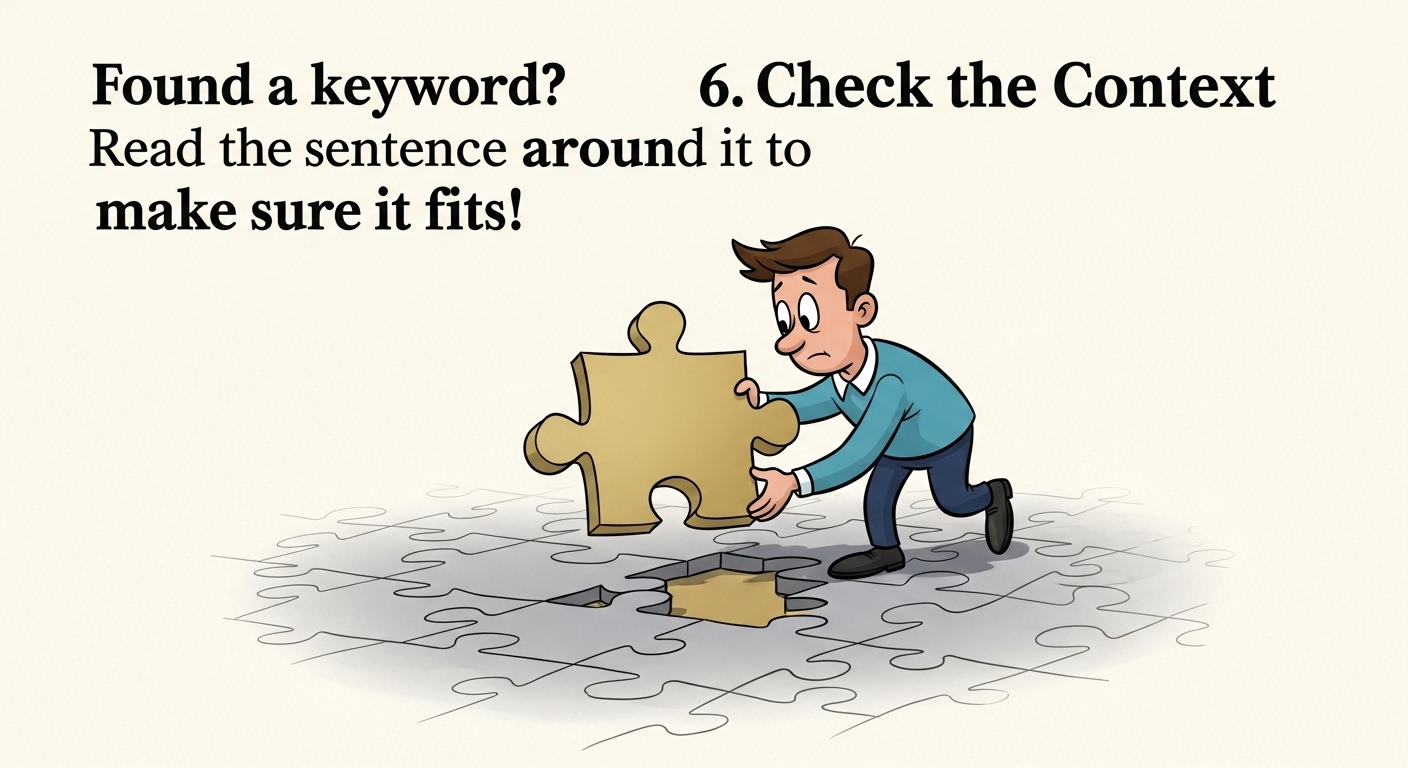
Before we wrap up, here are some final pointers:
- Practice Regularly: Make scanning a habit. Set aside time to practice with IELTS readings or even news articles. The more you practice, the quicker you’ll recognize keywords and patterns. Cambridge experts also stress that “skimming is a skill that improves with practice”, and the same goes for scanning.
- Stay Calm During the Test: Avoid panic. If a keyword isn’t found right away, move on and come back. Better to answer easier questions first as they may give clues for harder ones.
- Mix Difficulty Levels: Since our tips are for Band 6–8+, use a variety of materials. For instance, if a paragraph is very dense, practice breaking it down into scanning chunks. If it’s lighter, practice spotting details quickly.
- Use Scratch Paper: On test day, quickly jot down question keywords on your question paper or rough sheet. It helps keep your eyes on the passage.
- Pair with Skimming: Remember that scanning works best with skimming. Skim the passage for a minute if the topic seems unfamiliar, then dive into scanning. By following the strategies above and practicing with actual passages like we did, you’ll become proficient at using keywords to scan. In the IELTS Reading test, treating questions as a guide to what to look for in the text is key. When you do this successfully, you spend far less time reading irrelevant parts and more time verifying answers. Good luck! With consistent practice using these scanning techniques, you’ll improve your speed and accuracy. Soon you’ll find yourself answering IELTS Reading questions more efficiently, leaving more time to double-check and tackle even the toughest passages.

About the AuthorWelcome to TechIELTS. I’m Md. Jahangir Alam, an experienced engineer with over 15 years in electrical and automation systems. Alongside my engineering career, I’ve developed a strong interest in English language learning and IELTS preparation.
I hold a Duolingo English Test score of 135 (IELTS 7.5 equivalent) and am currently pursuing an M.Sc. in Cyber Security from Royal Holloway, University of London. I use my technical background to create clear, structured IELTS learning materials for students and professionals.
👉 Connect on LinkedIn
